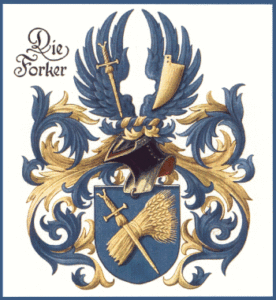Dear relatives and friends,
the 10th anniversary gathering was a great success for us.
Here’s the most important thing: There will be an 11th meeting.
Wigand and his wife Monika have come from our midst
from Butzbach south of Giessen and Egbert from Dresden, thank you
worthwhilely agreed to continue to look after the family association
take care of.
The minutes of our meeting will appear here soon,
first of all what Anja Weber wrote in the SZ before our meeting.
And of course the obligatory photo of the participants.
ps. Thanks for organizing and conducting the meeting,
arrived from different directions.
Your Joachim
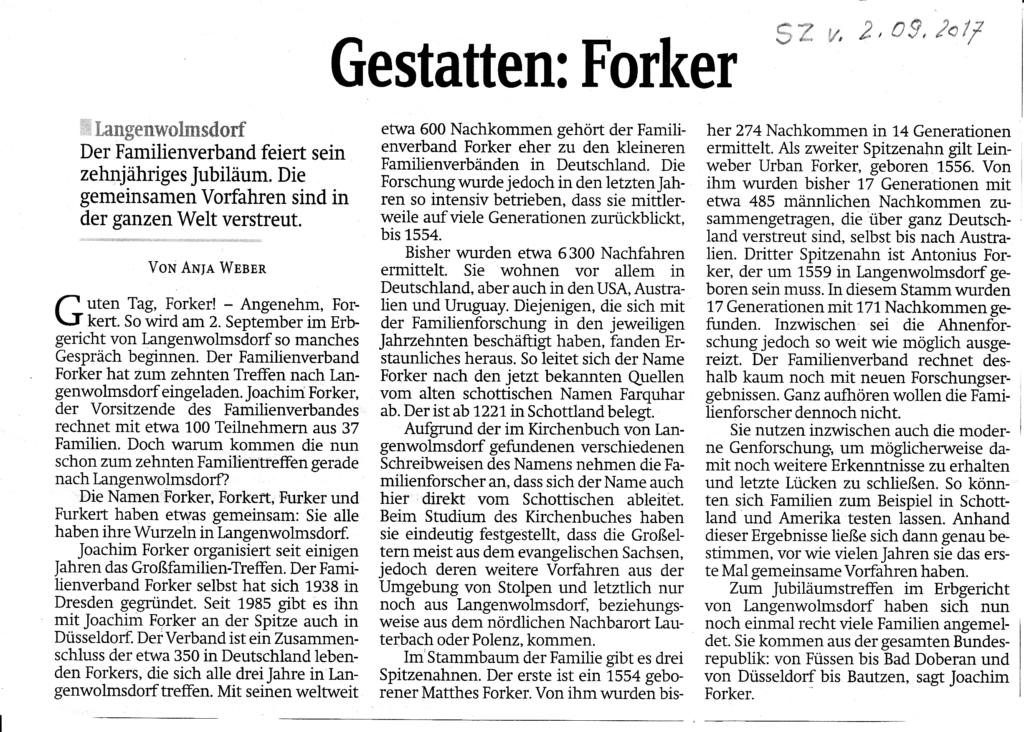
MINUTES of the 10TH ANNIVERSARY FAMILY GATHERING
in the restaurant “Erbgericht”
to Langenwolmsdorf
on September 03, 2017
Participant
Director Joachim Forker (Dusseldorf)
Organization Marion Forker-Hollitzer (Großkrotzenburg)
Speakers Joachim Forker (Düsseldorf)
Church representative Pastor Christian Heurich
Sexton Mrs. Grützner
Cantor Christine Seipold
Guests of honor Mr. Uwe Steglich, mayor of the city of Stolpen
Guests Uwe and Edeltraut Rosendahl (Brunswick)
Ralph and Edith Jatzke (Langenwolmsdorf)
Press Anja Weber (SZ)
Entertainment cabaret and cabaret “Die Pirnaer Mosquitoes e.V.”
Protocol Wigand Forker (Kirch-Göns)
Family members invited with the date 01/15/2017 250 invitations
Registered by 08/17/2017 98 people
sorry missed 6
absent without notice 24
appeared unannounced 6
total present 68
Program items and procedure
1st meeting the evening before, Forker Stammtisch September, 1st 2017, 6:00 p.m
The Forker regulars’ table in the Langenwolmsdorf inheritance court, after three years there is a lot to tell.
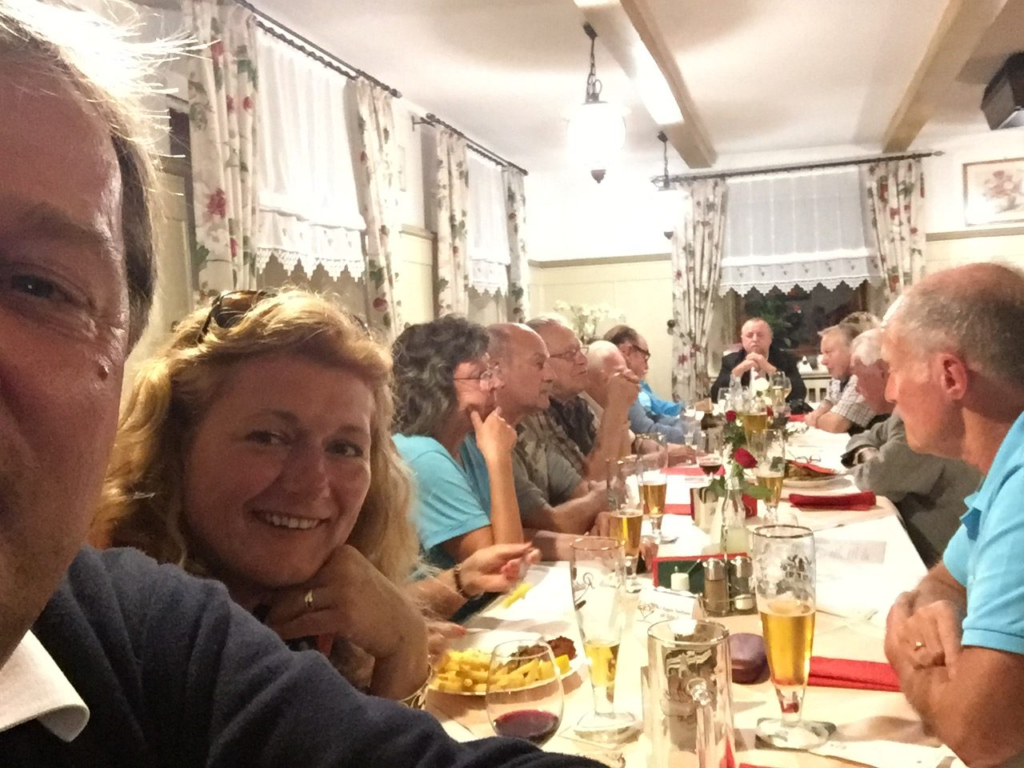
2. Forker Family Gathering September, 2nd 2017, 2.15 – 2.30 p.m
Church visit – devotion
Slightly late, after the handing out of the name tags in the church, the organ joined in with the song “Meine Zeit ist in dein Handen” (My time is in your hands) in the Langwolmsdorf church and then Pastor Heurich began his prayers. He held out his identity card, enlarged to DIN A4 landscape format. The card as proof of identity shows where we come from, when we were born. Behind the identity is a name. This name does not change when life circumstances change. Behind it is a piece of home. Pastor Heurich also reported on the painting “Last Supper by Leonardo da Vinci” including a portrait of a small ship that Leonardo had been painting for almost three weeks. At the time, visitors to the exhibition were only interested in finding the ship, which annoyed Leonardo. Without further ado, he removed the small ship in the painting.
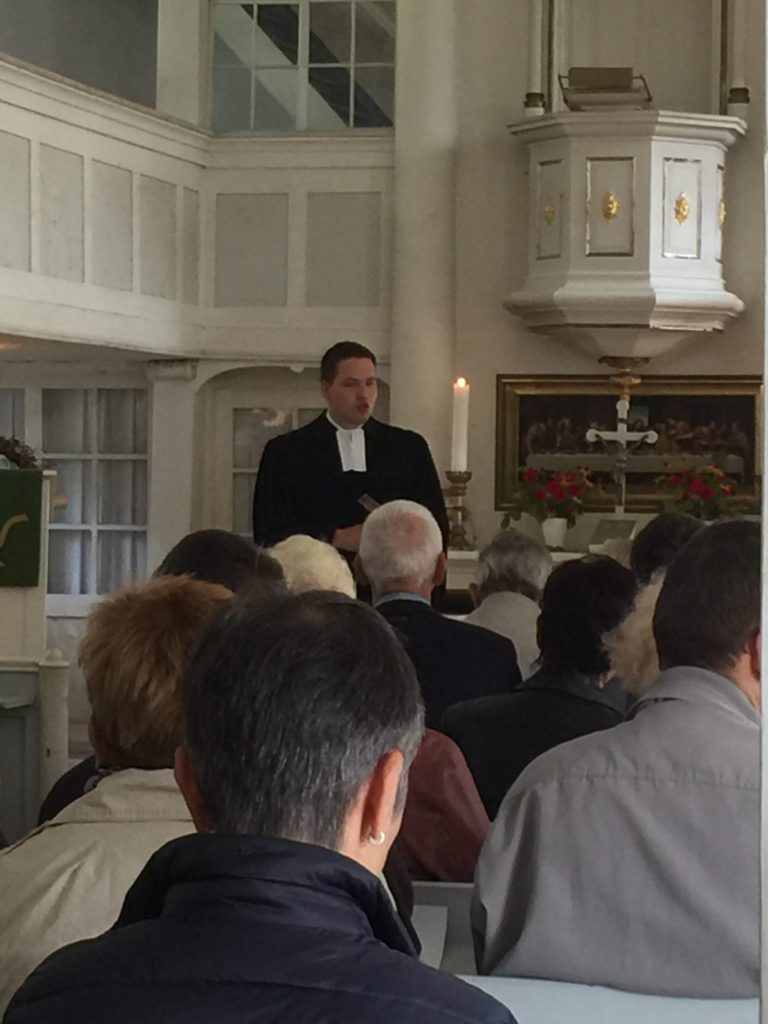
The devotional ended with the song “Lord, we ask you to come and bless us”.
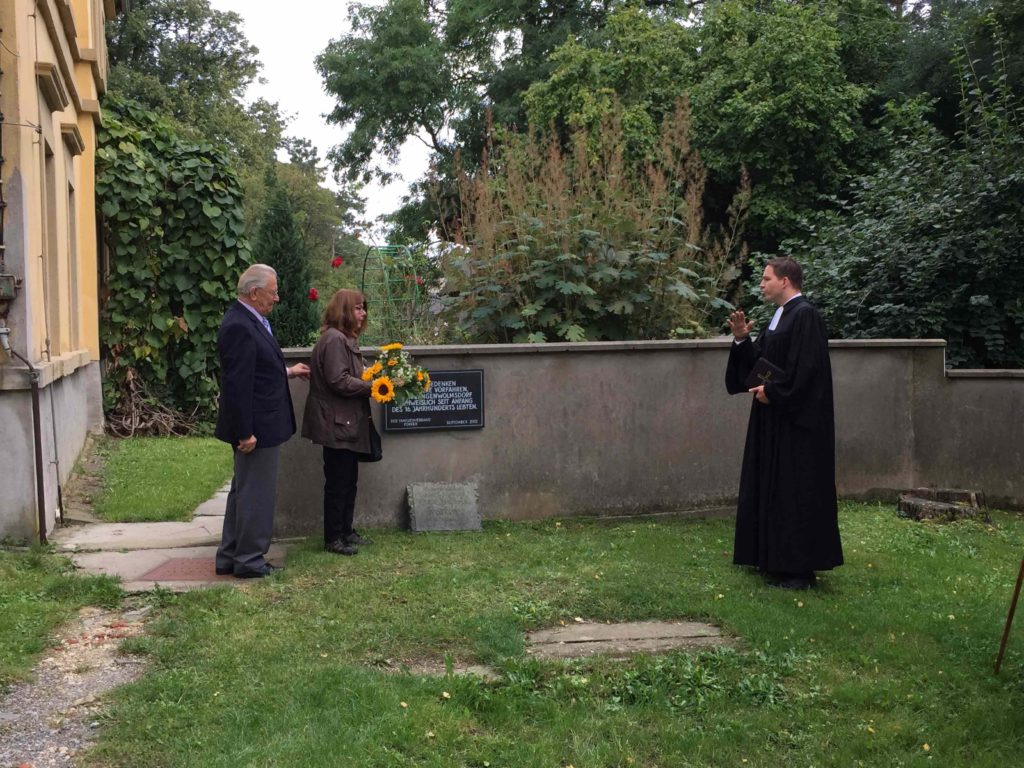
Afterwards we stayed a few minutes at the pedigree to commemorate our deceased and laid down a bunch of sunflowers.
3. Mandatory family photo in front of the entrance to the church grounds 2:45 p.m. – 3:00 p.m
After the commemoration of the ancestors, the obligatory family photo was called for. Unfortunately, this call did not reach the back row, so that not everyone involved could get on the family photo.
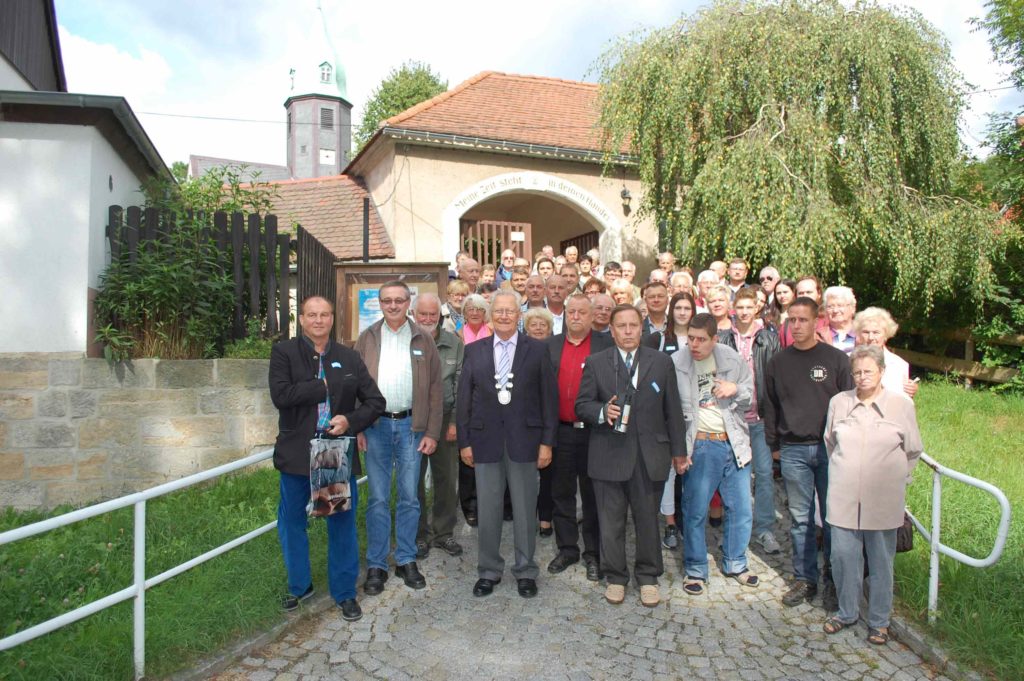
4. Drinking coffee together 3.05 – 4.30 p.m
Joachim addresses those present with the words:
“Dear relatives and friends of the family association, after our joint church visit here in Stolpen, in OT Langenwolmsdorf, the ancestral seat of our ancestors, we warmly welcome you. A special greeting also goes to Mayor Steglich, who has been honoring us for several years. Before anyone wonders, I would like to say in advance that we decided at the last meeting to address each other by first names or to use the first name, as this has been a matter of course in a family for several generations. We are particularly pleased that you all showed your interest in the extended family by coming and that our efforts were worth it.
The visit from the edge of the Alps to the Waterkant, from the Rhine to the Elbe shows how important it is for those of us to be present at this meeting. But young and old are there too. So once again a warm welcome to the soil of your forefathers.
Dear Mayor Steglich, now I give you the opportunity to say your words of greeting in your city, in our family.
Mayor Steglich warmly welcomes those present from the “only family”. The considerable achievements in family research that have already been achieved find his full recognition. Mr. Steglich advertised the upcoming 800th anniversary of the town of Stolpen. Joachim continues his remarks: “We wrote that this 10th anniversary meeting should be something “special big”, simply to emphasize that it is something special for a family to meet for the 10th time three years apart. I don’t want to go unmentioned that we met in 1990 for a kind of founding meeting in Erkrath on the outskirts of Düsseldorf and from then on regularly here in the inheritance court in Langenwolmsdorf, where our Fork ancestors met in the municipal council and certainly enjoyed many a beer.
This should initially be the keyword that we want to drink coffee together and this time take more time to get to know our table neighbors and to find out from which branch they come, or what we have in common and what unites us. Our meeting is the 10th = 10×3 years, 30 years, there will also be an 11th meeting, because Wigand and Monika have agreed to organize the 11th meeting now.
Then get: Marion for the great organization and Wigand and Monika for taking the minutes, each a bottle of “Düsseldorfer Killepisch”.
We wish you a nice cup of coffee and lots of joy in gaining new insights!
4. Drinking coffee together
For the collection that takes place in the meantime, we ask you once again to be generous so that we can settle our expenses for this meeting.
Thank you for your attention.” (end of quote)
Joachim thanks Mrs. Nestroy for the hospitable reception and hospitality with a bouquet of flowers.
In front of the printed genealogical tables, numerous interested people come together to talk. After a short time, a murmur went through the hall, some ran back and forth to the printed genealogical tables. The riddle could be solved, inadvertently the progenitors were wrongly assigned on the name tags. That won’t happen again at the next Forker meeting. Everyone involved should now receive a name tag. To identify the progenitors, they are distinguished from the others by colors. The wish was also expressed to divide the tables according to progenitors in the future. This may make it easier for some of those involved to start a conversation with their direct/indirect relatives. The organization will include this request as an item when planning the next Forker meeting.
Jürgen from Seevetal takes the initiative with Hamburg charm and expresses his gratitude and appreciation to Joachim on behalf of all participants for his tireless work. Not everything can be done through selfless work, because the organizational preparations required financial effort that should be borne jointly. He announces that he will use his collecting skills to supplement the budget for the purpose mentioned. His request was generously granted.
5. Lecture and entertainment 5:25 – 7:00 p.m
Joachim turns back to those present:
Dear attendees, according to the program I come to the report 90 years of family research, 1927-2017. how did it start
It started in 1927 when the retired city treasurer Paul Forker was 73 years old. His father came from a farming family here in the village, as did most of our ancestors. Paul had 3 brothers, his mother was also a born Forker, with only one sister and one brother of 10 born children. Both of his parents had inherited their parents’ farms and were from the area. So in Paul’s youth there were always plenty of relatives coming to family celebrations, most of them with the surname Forker. As the youngest, he was interested in old age, but who were the Forkers who were always present? He was familiar with paper and pencil and so he first collected the data from the extended family and wrote it down as master data on the back of wallpaper. Once started, the work he had started would not let him go. He kept looking and found plenty of ancestors and descendants of his family in the local church book.
He organized the first meetings of the forkers, founded the family association as an association with statutes and contributions, and he donated our family coat of arms. After 1945 Paul brought his notes from Dresden to Bergisch-Gladbach (east of Cologne) to his son Prof. Georg Forker.
Until 1945 he was director of the Plaunsche Oberschule in Dresden. He had always supported his father in his research and kept his records. In this way, they passed on to the next generation, grandson Hans-Georg, whom many of you still experienced as honorary president here. He, too, was only able to devote himself to his grandfather’s legacy, family research, at the end of his professional life.
This is where I start, as a Dresden-Loschwitzer I went to Düsseldorf in 1956. A family book I inherited from my father made me want to see if I was the only forker in the Rhineland. In the process, in 1985 in Mönchengladbach, I came across the master mechanic Siegfried, who then already knew Klaus in Lohmar (our secretary, who unfortunately died last year) and Hans-Georg.
After a mutual meeting, a friendly basis developed, after which Hans-Georg, who through his initiative, now typewritten notes, his grandfather bequeathed me and thus also the original Forker descendants chart on the back of a 9 m roll of wallpaper.
In 1990, after extensive research into living Forkers, the preparatory work had progressed so far that the first post-war meeting was organized in Erkrath on the outskirts of Düsseldorf. The Forker family association had already ceased to exist before the end of World War II.
At this meeting, after German reunification, it was decided to hold the 2nd meeting in 1993 here in Langenwolmsdorf. A previous written survey of the participants revealed that 71% would like to found an association, 60% were in favor of voluntary donations to make the work possible, 64% wanted meetings every 3 years and 54% voted for meetings here in the inheritance court. 74% voted for information. Other proposals did not receive a majority at the time. So also the desire to end the finale with dance.
After this clear vote, the past family reunions took place, we reported on our family research and the constantly growing knowledge. Who is whose child, where do the forkers come from, where does our name come from, what does modern DNA research tell us.
Although I have to mention that there is still enough to be explored, we have not yet united all branches, that is to say, their top ancestors have not yet been explored.
In 1999 our family brochure was published and during the 5th meeting in 2002, we unveiled the plaque in the local cemetery honoring our ancestors.
We have been on the Internet since 2002 and to date there have been almost 27,000 visitors to our website, but the next generation also meets on Facebook.
The fact that our meetings have so far aroused your interest is shown again today by the numerous gatherings. Monika just announced that 68 people are present. My question about this? If someone is here for the first time, well that makes us happy, very nice – so it can go on like this.
We think that our meetings have worked out well, get together, see each other again after years, talk about family, children and grandchildren and how things are going. That was it!! The purpose of family reunions since ancient times.
Always about 80-90 participants, 10 times, as often as never before. This is something special!!!
If you have asked yourself why the invitation says that this could have been the last meeting, the reason is quickly found.
I am confident that someone from our circle will be willing and I am sure that the extended family will meet here again in 3 years.
If anyone would like to add, expand or reply, this is the opportunity for your questions. (no requests to speak)
You can read what has been said here later on our website.
Joachim (end of quote).
Again, the organization has come up with something great for entertainment.
Clear the stage for the “Pirna mosquitoes”.
⦁ With the program items:
⦁ registry office.
⦁ Why can’t a child be called Adolf.
⦁ Integration Policy.
⦁ Men in hardware store.
⦁ Consumer Advice Center – One for all.
An hour of entertaining entertainment flew by and the cabaret artists said goodbye to hearty applause.
6. To the end
Joachim answers the concerns of a number of questioners and wishes all participants a good time and the journey home and the wish to see you here again in three years.
This officially ended the 10th Forker meeting at 7:00 p.m.
Meanwhile, helping hands bring the exhibit materials into transport-ready condition so the work doesn’t have to be done on a Sunday morning. The dining room in the hereditary court is almost completely occupied by the Forkers. The range of food and drinks allows everyone to find something to their liking. The lively exchange of information and ideas continued until late in the evening at a cozy get-together.
Correspondent: Klaus Forker
